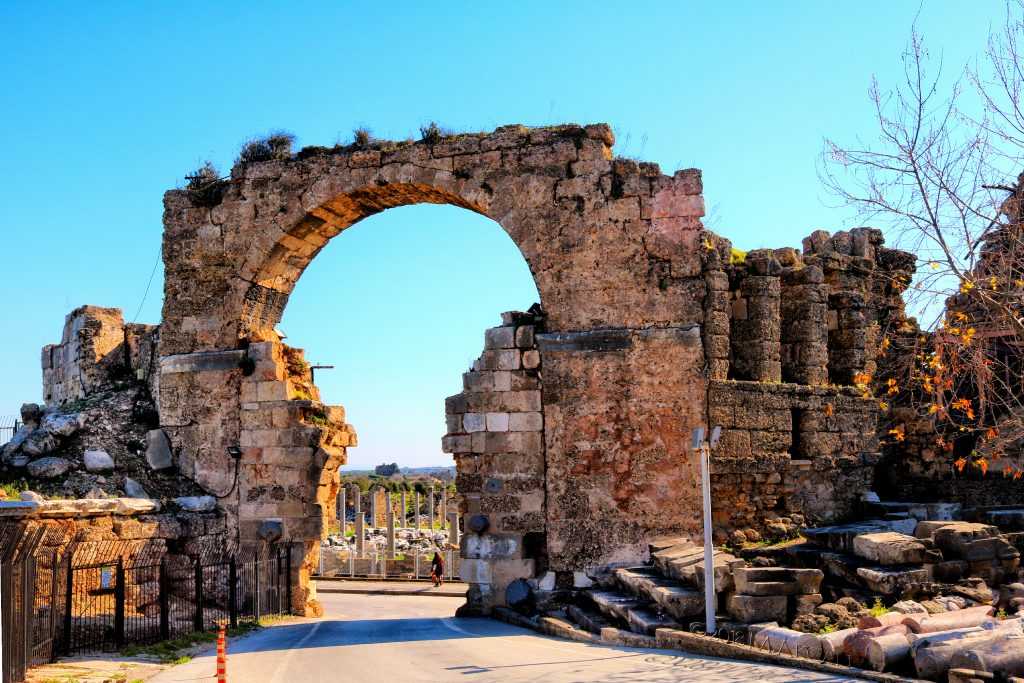Side is an ancient settlement located on the peninsula near Selimiye neighborhood of Antalya’s Manavgat district.. The entrance to the ancient city of Side is free unlike the ancient city of Ephesus.. It is one of the must-visit places for those who want to make a Mediterranean cruise.
Side is a goddess and the word means pomegranate in Anatolian languages.. Side, the goddess of nature and fertility, goes to the banks of the Melas (Manavgat) river to collect flowers with her daughter and Nymphs (forest nymphs).. She likes the flowers of a colorful tree very much, she cuts a branch to give her daughter one of the flowers of this tree..
As soon as you cut off the branch, something suddenly happens, it can’t move and it starts to turn into a tree.. Because the tree whose branch he cut is a goddess who turned into a tree to protect him from bad people.. The forest nymphs are very upset about this situation and cry and wet Side’s feet rooted in the ground.. Realizing his mistake, he tells the nymphs: “From now on, with my blood-colored fruits, I will be the symbol of nature and life.. Bring my daughter here often. Let him play in my shadow and tell him not to pluck any flower. Do not harm any trees. Maybe every tree or flower is a transformed goddess.”
This is why Side is identified with pomegranate trees and there are many pomegranate trees in the city.. According to the information obtained from some inscriptions, the ancient city of Side dates back to 7 BC.. It was founded by Greek settlers coming from western Anatolia in the 16th century.
You can find the road map of the Ancient City of Side here.
Ancient City of Side
City of Mythology Side
Apollo in the ancient city of Side There is the temple of Athena. Although the people gave equal respect to both gods,. From the 19th century onwards, the importance of Apollo increased and he was accepted as the founder of the city by the inhabitants of the city, and plays were started to be held in his honor.. 2nd. century, the temple took its present form.. The Medusa statue in the temple was restored in 1980. Entry to the temple is free but partially closed to visitors. You can add this temple to your Places to visit in Side list.
If you want to make a
Mediterranean cruise, you should also see the southern basilica in the ancient city of Side.. Southern basilica, 5 BC. It was built in the century Athena and Apollo.. The basilica has 3 naves and a large atrium.. There are corridors in the building with benches in the corners on which the priests can sit.. In the basilica there are rooms of priests and rooms where offerings are made to the gods.. Its center is located southeast of the basilica.. It is also thought that there was a saint’s tomb for a period in the basilica.. 7 of the building where the tomb is located. It is thought that it was used by demolition to make a smaller church in the century.. The southern basilica is close to the temple of Apollo.
The Historical Building of the Ancient City
The ancient city of Side, 6 BC. In the first half of the century, it was under the rule of the Lydians, and between the years 547-546 BC, the Persians.. Alexander the Great captured the city, which developed under Persian rule, in 333 BC without encountering any resistance.. Alexander the Great left only one garrison in the city, and as a result, the people met the Hellenistic culture.. Hellenistic period 1 BC. It took a century. After the death of Alexander the Great, the ancient city of Side was built in the 1st century BC, who declared himself the king of Egypt in 305 BC.. came under the rule of Ptolemy Soter. Ptolemaic dynasty, ancient city 2 BC. century, but could not protect the city against the attacks of the Seleucid empire.. Despite these occupations, the ancient city of Side gained the right to be a semi-autonomous region, continued its development and continued to be an important cultural center.
Ancient City Hellenistic Period
One of the artifacts from the Hellenistic period. Side Nymphaeum. Nymphauem, 2 BC. It is a huge water fountain built in the XVI century.. It is right across the main gate of the ancient city.. It was once a large three-stepped building on the edge of the city and has 9 flowing fountains.. The nymphaeum was a water fountain 20 meters high by 52 meters wide in ancient times. However, due to the earthquakes, its height decreased to 12 meters.. It was once the most impressive water fountain in the area. It was made so splendidly to impress the visitors of the city. Water was flowing into this fountain with a 30 km aqueduct connected to the Manavgat river.. Aqueduct AD 3. It was renovated by Bryonianos Lollianos, a wealthy citizen in the 19th century, at his own expense.
In 190 BC, the navy of the city-state of Rhodes, with the support of the Roman republic and the Pergamon kingdom, defeated the Seleucid navy under the command of the famous Carthaginian general Hannibal.. King 3 with the signed Apamea treaty. Antiochus was forced to leave all the settlements in Europe under the rule of the Seleucid empire and left all the settlements in the north of the Taurus Mountains to the Pergamon kingdom.. Despite this, the ancient city of Side gained its independence.. 1 BC. In the 16th century, the city reached the height of its power with the start of the slave trade with the Cilician pirates.. The pirates were selling their slaves in the commercial agora of the city of Side.
Side had two agora, the commercial agora and the state agora.. The commercial agora is more than 8000 square meters. Side agora was surrounded by high columns and was surrounded by merchants, toilets (latrina), washing places and sitting areas.. An unimaginable number of slaves is thought to have been sold here.. Side was a general center frequented by pirates.. In the middle of the Commercial Agora is a temple of Tyche, the patron goddess of the city.. temple 2 BC. Although it was built in the 16th century, it was also used during the Byzantine Empire.
Traces of the Hellenistic Period
The consul of the Roman republic, Servilius Vatia, defeated these pirates in 78 BC and later in 67 BC, the Roman general Pompey He took Side under the rule of the Roman republic.. Within the scope of the remfors of the Roman emperor Augustus, the ancient city of Side was connected to the province of Galatia and the city lived its second golden period.. The city became the trade center of olive oil, and they also managed to become the center of the slave trade in the Mediterranean.. The stable period of the ancient city of Side 4 AD. It has been in decline since the twentieth century..
As a result of centuries of attacks and looting by Christian bandits and Arabs, the inhabitants of the city lived in 10 AD.. It caused them to leave Side and move to Antalya in the century.. although 12. Although it was temporarily re-established as a big city in the 19th century, the inhabitants of the city left the city again due to looting.
The state agora has a more formal character than the commercial agora.. The eastern side of the state agora was called the emperor’s hall, and there are more than 20 Greek statues, including the statue of Antoninus Pius.. This was an indication that the city had the imperial cult (status of neokoros).. In the center of the state agora, there is a structure whose purpose is unknown.
Ancient City Side
It is called the main gate of the ancient city or the Vaspesian (one of the Roman dynasties) gates.. It is protected by towers on either side of the main gate.. The main gate is located away from the ancient excavations and ruins. Around the main gate there are tourist services, shops where tourists can shop.. There is also a gate to the east of the city.. There is a columned road between the main gate of the city and the ancient theater.
Side harbor baths got their name because of their proximity to the port.. The work was built during the Roman period. There are also many artifacts in the ancient city that are still unsolved.
One of the important stops for those who want to make a
Mediterranean cruise is the Side museum.. Side museum is an ancient roman bath converted into a museum with the restoration in the ancient city.. The museum collection consists of artifacts excavated between 1946-1966.. The museum bears the title of the first museum opened in a village in Turkey.. The museum collection includes artifacts from the Hellenistic, Roman and Byzantine periods.. Among the exhibits, statues, column capitals, torso portraits, tomb steles, altars, amphorae, architravy frieze column, inscriptions in Greek and Side language, embossed sarcophagus and ostotes, pediments, etc.. architectural elements; Side coins and coins belonging to the cities of Pamflya and Pisidia are found..
Side museum entrances are paid and the museum is closed to visitors on Mondays.
Side ancient theatre, 2 AD. Although it was under the rule of the Roman republic in the 19th century, it was built according to the Greek architectural style.. Its approximate capacity is 15 thousand people.. The stage of the theater was damaged, possibly due to a severe earthquake. Ancient theatre, 5 and 6 AD. It was used as an open-air church for centuries.. Entrance to Side ancient theater is paid, it is closed to visitors on Mondays.
Temple of ApollonapollonPlaces to visit in Side







